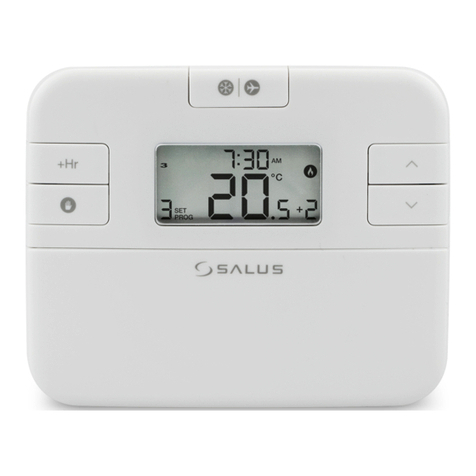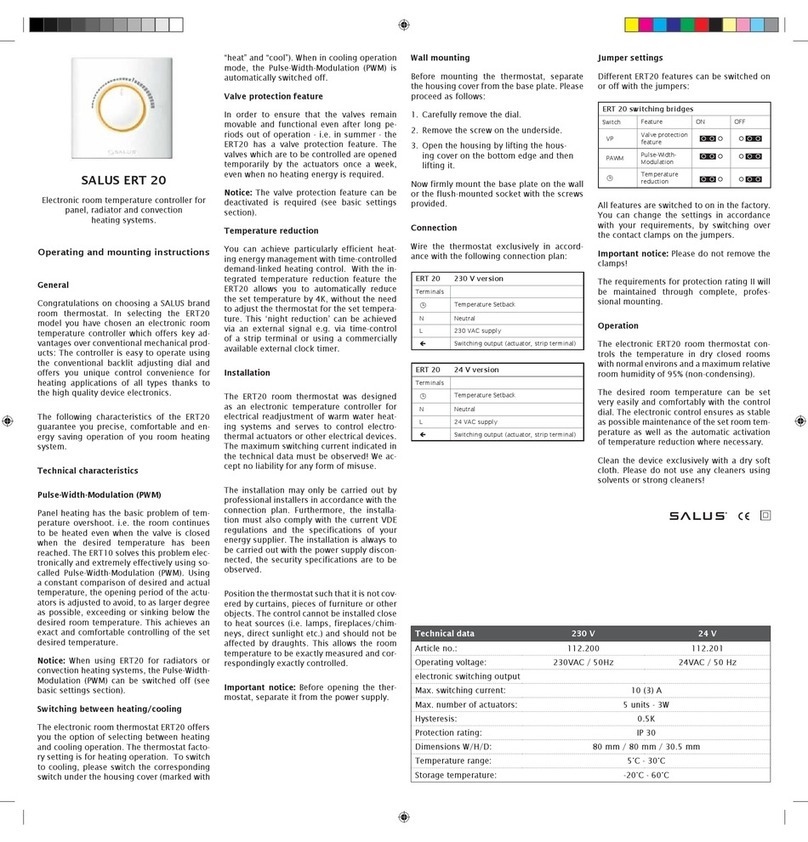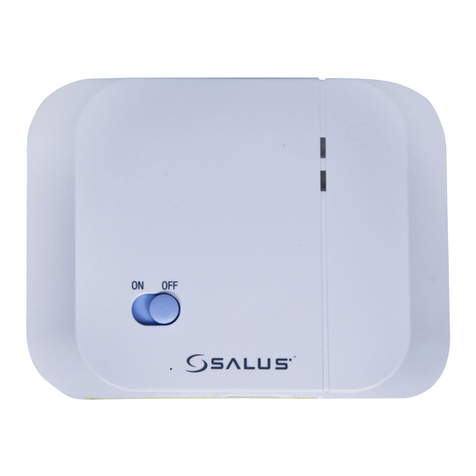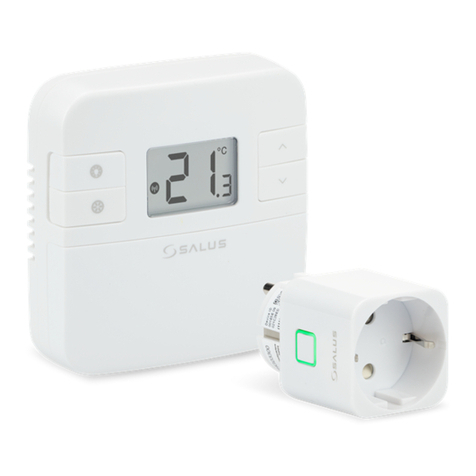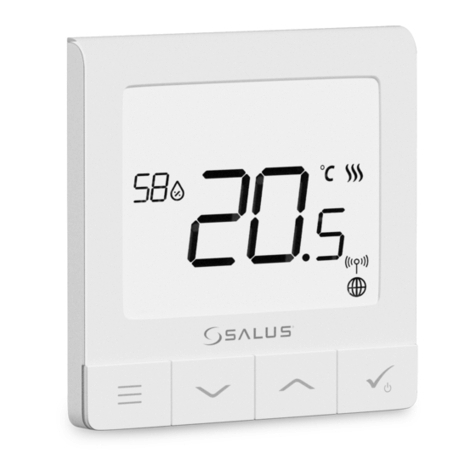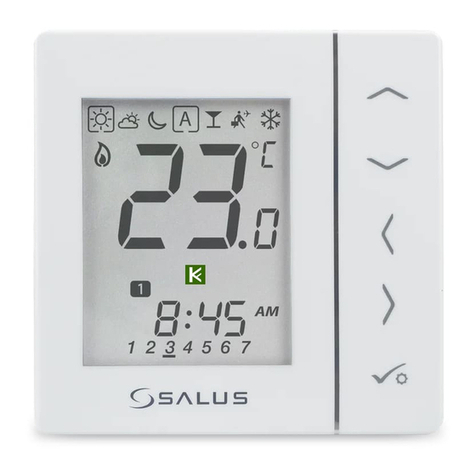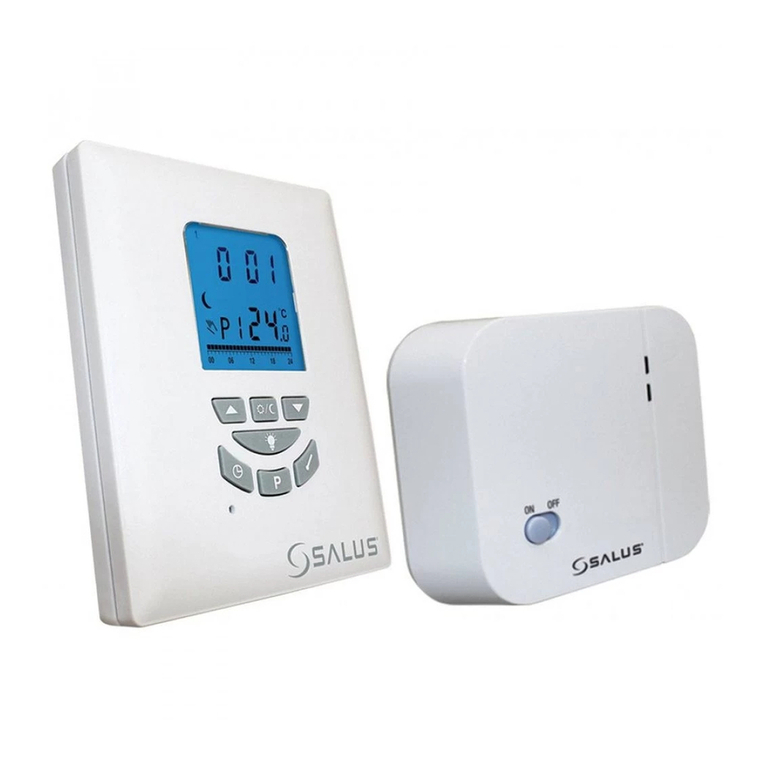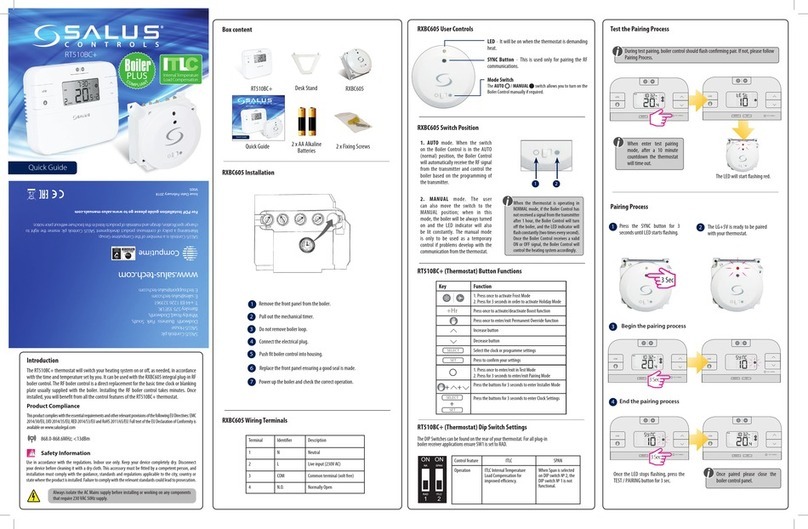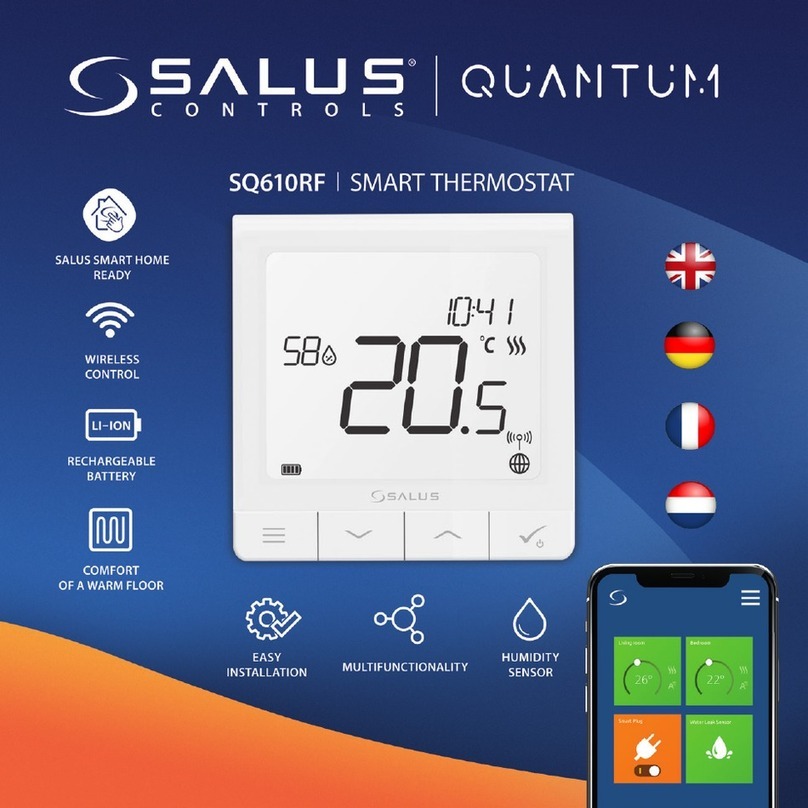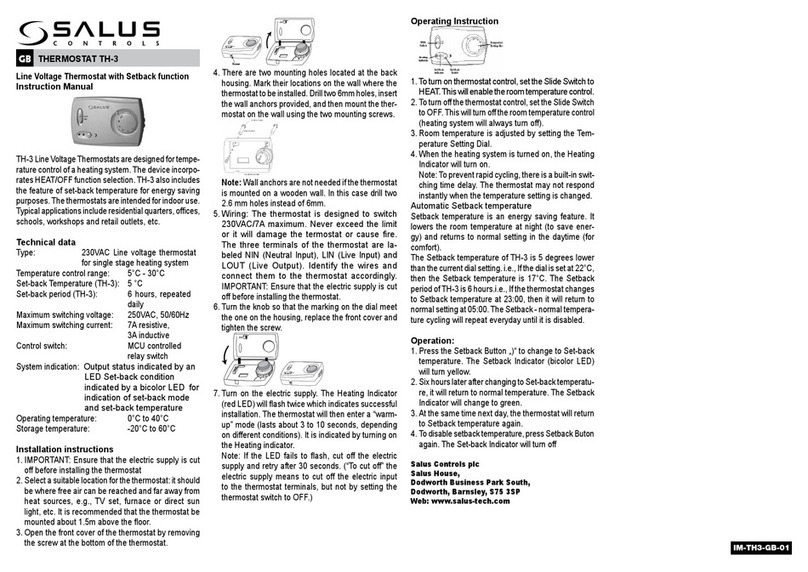ERT30RT Noiseless
Digital Room Thermostat
for Underfloor Heating
with Remote/Floor Input
Product Compliance
This product complies with the essential requirements of the
following EC Directives:
• Electro-Magnetic Compatibility Directive 2004/108/EC
• Low Voltage Directive 2006/95/EEC
• EC Marking Directive 93/68/EEC
SAFETY INFORMATION
These instructions are applicable to the Salus Controls model
stated on the front cover of this manual only, and must not be
used with any other make or model.
These instructions are intended to apply in the United Kingdom
only, and should be followed along with any other statutory
obligations.
This accessory must be fitted by a Competent person, and
installation must comply with the guidance provided in the
current editions of BS7671 (IEE Wiring Regulations) and Part ‘P’
of the Building Regulations. Failure to comply with the
requirements of these publications could lead to prosecution.
Always isolate the AC Mains supply before opening or
removing the unit from the wall or wall box.
Please leave these instructions with the end user where they
should be kept in a safe place for future reference.
INTRODUCTION
A thermostat is a device that is used to switch the heating
system in your home on and off as needed. It works by sensing
the air temperature and switching on the heating when the air
temperature falls below the thermostat setting, and switching
it off once the set temperature has been reached.
The ERT30RT from Salus Controls is a stylish and accurate digital
room thermostat that is fitted with a large easy to read Liquid
Crystal Display (LCD). The ERT30RT has been specifically
designed to be used with under floor heating systems.
A back light and frost function add to the features of the
ERT30RT.
FEATURES
• Remote/Floor temperature input
• Valve Protection
• Large, easy to read LCD with orange Backlight
• Stylish casing
• User friendly
• Frost protection
• Reset button
• Will operate up to 5 thermal actuators
• Selectable Set Back 2ºC / 4ºC
Installation
Please read the important safety information at the start of this
manual before you begin to install the device. The ideal position
to locate the ERT30RT digital room thermostat is about 1.5m
above floor level. It should be mounted in a location where the
thermostat is easily accessible, reasonably lit and free from
extremes of temperature. Loosen screw which is located on the
bottom of the housing. Open the housing by pulling the bottom
of the cover then lift off. Now mount the base plate with the
supplied screws firmly to the wall or onto the flush-mounted
wall box.
ERT30RT not only works by itself, i.e. dip switch setting, but
also can be controlled by two control methods, i.e. Night
Setback by clock, and Communciation Signal from ERT52 via
communication terminal.
The electrical connections to the ERT30RT are made to the
internal terminal strips. Connection details are shown below -
no Earth connection is required for the correct and safe
operation of the thermostat as the device is double insulated.
Terminal Connections
Terminal Description Terminal Block
Switched Output
L Mains Live
N Mains Neutral
Temperature setback (230V AC input)
Terminal Description
S1 Remote/Floor temperature sensor terminal 1
S2 Remote/Floor temperature sensor terminal 2
Remote/Floor Sensor 10K NTC Type
After installing the ERT30RT in a suitable location, wiring
connections can be made as shown above. The following criteria
apply to the installation:
• The incoming AC mains supply should be 230V AC
and fused at 6 Amps.
• Optimum cable size for installation is 1.5 square mm; wiring
colours should be in accordance with the current requirements
of the IEE Wiring Regulations.
• All wiring connections should be securely made, and be firmly
terminated within each of the terminal screw clamps.
Do not restore the mains supply to the system until all associated
items are fully installed.
NOTE: All electrical installation work should be carried out by a
suitably qualified Electrician or other competent person. If you
are not sure how to install this programmable thermostat consult
either with a qualified electrician, heating engineer or your
boiler / heating system supplier for advice on how to continue.
Do not remove or refit the ERT30RT wiring without the
mains supply to the system being isolated.
DIP Switch Settings
Changes to the DIP Switch settings should only be made by the
Engineer carrying out the installation or Another qualified
person. These DIP switches are located inside the unit. Follow
steps in the installation section on how to open the unit.
The installer should select the switch positions required if
changes need to be made to the factory default settings.
Switch Position Function
Sensor Mode Selection Int R/F Int+F Int: Internal Air Sensor only (default)
R/F: Floor or Remote Sensor only
Int+F: Internal Air and Floor
Sensor mode.
Switch Position Function
System Cool Heat Heat – Heating Mode (default)
Cool – Will set system to
cooling mode
Set Back
Temperature ºC reduction in heat mode
2ºC 4ºC
Temperature ºC rise in cool mode
Output Control Type On/Off PWM PWM – PWM output (default)
On/Off-Switch to on/off mode
Valve Protection (VP) Disable VP VP - Enable (default)
Disable- Disables VP
N.B: If the System DIP switch is set to ‘Cool’, PWM mode is
automatically disabled. In this case the ERT30RT will only
operate in On-Off mode, even if the Output Control DIP switch
is set for PWM mode.
After Installation
After completing installation and powering up
the ERT30RT for the first time the thermostat
will behave in the following way:
All the indicators on the display and the backlight will be turned
on for a few seconds. After a few seconds, the ERT30RT will then
operate in Normal mode (controller output OFF), and display
the current room temperature.
All the controller settings will be returned to the values stored
in EEPROM. If the Reset Button is pressed, the ERT30RT will
behave in the same way as described above, except that any
previously saved user settings will be deleted and overwritten
with the default settings.
Function Default Value EEPROM Backup
Operation Mode Normal Normal
Room Temperature 22ºC, updated 22ºC, updated
within a few seconds within a few seconds
All Set Point 10ºC - 35ºC Depends on setting
Temperatures stored in EEPROM
Floor Limit Internal Air Sensor + Depends on setting
Temperature Floor Sensor mode: stored in EEPROM
30ºC (heating mode)
15ºC (cooling mode)
ºC Indicator On Depends on setting
stored in EEPROM
Frost Setting Off Depends on setting
stored in EEPROM
Heat Indicator Heat Depends on setting
stored in EEPROM
Output Off Off
N.B: Please be aware that after a Reset, the ERT30RT output may
turn ON if the room temperature is lower than the Set Point
temperature in heating mode.
USER INTERFACE AND CONTROLS
The status and operation of the ERT30RT can be clearly seen on
the large orange backlit Liquid Crystal Display (LCD) - this display
allows the user to see at a glance the current status of the
heating system.
There are few user controls for the ERT30RT, making the
controller very easy to operate. These controls are shown below,
along with a description of each of their functions.
User Control Function Summary
Key / Operation Functions
MINUS (-) key Decreases the selected setting
PLUS (+) key Increases the selected setting
RESET button Restarts the ERT30 RT
Operation
As previously described, the ERT30RT is
configured and adjusted by the use of an
intuitive user interface with a minimal
number of user controls, and the backlit LCD gives a highly
visible, easily readable indication of the thermostat status.
LCD Indicator Function Summary
Indicator Symbol Function
HEAT Indicates heating mode is active
COOL Indicates cooling mode is active
CRESCENT Indicates setback temperature mode is active
TEMPERATURE Indicates either current room temperature
or set point temperature
FROST Indicates frost protection mode is active
HEATING Indicates heat control mode is active
Checking the Set Temperature
Pressing either the PLUS or MINUS key twice
will display the current Set Point
temperature:
After a few seconds without a key press, the ERT30RT will return
to NORMAL mode and will display the current room
temperature.
Adjusting the Set Point Temperature
Adjusting the Set Point temperature is
done with the ERT30RT in NORMAL mode.
Press either the PLUS or MINUS key twice
to enter setting mode. After doing this, the
displayed Set Point temperature will flash:
Press the PLUS or MINUS key to increase or decrease the Set
Point temperature within the range of 10°C to 35°C, in 0.5°C
steps. The Set Point temperature will stop flashing while being
adjusted, but will flash again once the key is released. Pressing
and holding the PLUS or MINUS key for two seconds will
increase or decrease the setting quickly.
The thermostat will return to NORMAL mode after a few
seconds if no key is pressed.
Frost Protection Mode
The ERT30RT has a Frost Protection mode,
but this is only active when the thermostat
is operating in Heat mode. The Frost
Protection mode temperature is preset at
5ºC; this temperature is factory set and cannot be adjusted.
To enable Frost Protection press the PLUS and MINUS keys
together for a few seconds, then release them. The display will
then display the Frost Protection Set Point and Frost icon:
To disable Frost Protection and return the thermostat to
NORMAL mode, press the PLUS and MINUS keys together for a
few seconds.
Adjusting the Offset Temperature Setting
The Offset temperature setting can be
reviewed or adjusted by entering the Offset
Temperature Setting mode. This is done by
pressing the PLUS and MINUS keys together
for a few seconds. The display will change
and display ‘Set’, as shown here:
To release the keys review the Offset
temperature, press either the PLUS or MINUS
key; the display will change to show the
current Offset temperature:
The thermostat will return to NORMAL
mode after a few seconds if no key is
pressed. To change the Offset temperature,
press either the PLUS or MINUS key to enter
the Offset temperature setting mode: the
displayed temperature setting will then flash
to show that it can be changed:
Press the PLUS or MINUS key to increase or decrease the Offset
temperature within the range of – 3.5°C to + 3.5°C, in 0.5°C
steps. The Offset temperature will stop flashing while being
adjusted, but will flash again once the key is released. Pressing
and holding the PLUS or MINUS key for a few seconds will
increase or decrease the setting quickly.
The thermostat will return to NORMAL mode after a few
seconds if no key is pressed.
Setting the Floor Limit Temperature
The Floor Limit temperature is active when the ERT30RT is set
for Internal Air Sensor + Floor Sensor operation, and can be set
in two modes: heating or cooling.
Heating:
Changes to the settings are made by
pressing the PLUS and MINUS keys together
for 7 seconds. The display will change and
display ‘HL’ and a static Heating icon, as
shown here:
Releasing the PLUS and MINUS keys will
then allow the ERT30RT to change to a
flashing display showing the last or default
High Limit temperature setting:
Press the PLUS or MINUS key to increase or decrease the High
Limit temperature in 0.5°C steps. The High Limit temperature
will stop flashing while being adjusted, but will flash again once
the key is released. Pressing and holding the PLUS or MINUS key
for two seconds will increase or decrease the setting quickly.
The thermostat will change to the Low Limit setting after a few
seconds of no key presses, as shown here:
The display will show the last or default
Low Limit temperature setting. This can be
changed in exactly the same way as the
High Limit setting.
The thermostat will return to NORMAL mode after a few
seconds if no key is pressed.
Cooling:
If the ERT30RT is set for cooling mode,
there is no High Limit setting to adjust.
Changes to the settings are made by
pressing the PLUS and MINUS keys together
for 7 seconds. The display will change and display ‘LL’ and a
static Frost icon, as shown here:
The Low Limit setting for Cooling can be changed in exactly the
same way as previously described for Heating.
Floor Sensor Error Mode
The ERT30RT has an inbuilt sensor error mode. If the thermostat
detects a fault with the floor sensor an error code will be shown
on the display. The display will alternate between the error code
and the current room temperature.
Display Description
Normal operation – room temperature displayed, backlight off
Error E1 – over floor temperature limit, backlight off
Error E2 – floor sensor open circuit, backlight flashes
Error E3 – floor sensor short circuit, backlight flashes
When the sensor fault is repaired, the thermostat will return to
NORMAL mode and display the current room temperature.
OTHER FUNCTIONS AND CONTROLS
Backlight
The backlight of the ERT30RT is switched on automatically
whenever any of the keys are pressed. The backlight will remain
illuminated for a few seconds after the last key press. If the
room temperature is higher than 35°C, the backlight will blink
on and off; this blinking effect also happens if the thermostat
senses that the floor sensor is disconnected or faulty.
The backlight will not illuminate if there is no mains supply to
the controller.
Control Status
The ERT30RT indicates on the LCD the control status by using a
selection of display icons.
Heat Control: The HEAT icon is displayed whenever heat control
is activated, along with an animated flame icon.
Cool Control: The COOL icon is displayed whenever cool control
is activated, along with an animated frost icon.
Reset Button
Resets the Thermostat to restore the settingsfrom internal
memory.
Setback Temperature
The ERT30RT has a provision to set a setback temperature;
Temperature is reduced by selectable 2ºC / 4ºC in heating mode;
or increased by selectable 2ºC / 4ºC in cooling mode.
The Setback feature will only operate if a connection is made
to the Setback terminal . If the terminal state is HIGH (above
175V AC), the Crescent indicator will be shown on the display,
and the Setback temperature will be applied.
Software Protection
The ERT30RT has several protection features built in to the
software. These features are:
• The heat control will be automatically turned off if the room
temperature is higher than 35°C, or if the floor sensor is
faulty.
• In cool mode, inbuilt short cycle protection prevents against
rapid switching of the output relay: the minimum delay
between the relay being on and off is 3 minutes.
• When operating in Internal Air Sensor + Floor Sensor mode,
the ERT30RT will turn off the heat if the floor temperature is
greater than the High Limit setting (to prevent any damage
to the floor surface). If the floor temperature is below the
Low Limit setting, then the heat will be turned on (to help
dry the floor, in for example a bathroom). If the ERT30RT is
operating in cool mode, then the cooling will be turned off
if the floor temperature drops below the Low Limit.
Temperatures outside the Operating Range
Temperatures exceeding the measurable range will be indicated
by ‘HI’ for temperatures above the upper limit, and ‘LO’ for
temperatures below the lower limit, as shown in the images
below:
Valve Protection Function
The Valve Protection (VP) function is provided as a way to avoid
the control valve from sticking or seizing when not being used
for long periods (e.g. during the summer).
This function is enabled by setting the Valve Protection DIP
switch to the enable position. When enabled, the VP function
will turn on the thermostat output to operate the control valve
for a period of 5 minutes every week: the VP function will still
operate even if the room temperature is higher than 35°C, or if
the sensors are faulty or outside of the high or low limits.
ENERGY TIP
One way to set and use your room thermostat is to find the
lowest temperature setting that you are comfortable with, and
then leave it set at this temperature. You can do this by setting
the room thermostat to a low temperature, (for example 17°C)
and then increasing the setting by one degree each day until
you are comfortable with the room temperature - you won’t
have to adjust the thermostat further, as adjustment above this
setting will waste energy: a 1°C increase in temperature is equal
to 3% of your heating costs.
Maintenance
The ERT30RT digital room thermostat requires no special
maintenance. Periodically, the outer casing can be wiped clean
using a dry cloth (please DO NOT use solvents, polishes,
detergents or abrasive cleaners, as these can damage the
thermostat).
There are no user serviceable parts within the unit; any servicing
or repairs should only be carried out by Salus Controls or their
appointed agents.
Should the ERT30RT room thermostat fail to function correctly,
check:
• Mains supply to the ERT30RT is switched on.
• Heating and Cooling system is switched on.
• If the ERT30RT is still not functioning correctly,
press the Reset Button.
WARRANTY
Salus Controls warrants that this product will be free from any
defect in materials or workmanship, and shall perform in
accordance with its specification, for a period of two years from
the date of purchase. Salus Controls sole liability for breach of
this warranty will be (at its option) to repair or replace the
defective product.
Salus Controls plc, Salus House, Dodworth Business Park South,
Whinby Road, Dodworth, Barnsley S75 3SP.
www.salus-tech.com Tel: 01226 323961
Product Specification
Model: ERT30RT NOISELESS
Type: Non-programmable Triac version digital
room thermostat
designed for underfloor heating applications.
Switch upto 5 thermal actuators.
Operation
Control Method:
1. PWM control (default)
2. On – Off control
Temperature Measurement
Internal Air Sensor or Internal Remote/Floor
Air Sensor + Floor Sensor Mode Sensor Only Mode
Temperature 5.0ºC – 45.0ºC (internal air sensor) 5.0ºC – 65.0ºC
measurement
range 5.0ºC – 65.0ºC
(floor sensor)
Temperature 5.0ºC – 45.0ºC (internal air sensor) 5.0ºC – 45.0ºC
display range
5.0ºC – 45.0ºC
(floor sensor)
Temperature 0.5ºC 0.5ºC
display
resolution
Set point 10.0ºC – 35.0ºC (internal air sensor) 5.0ºC – 45.0ºC
temperature (Frost mode 5.0ºC)
range (Frost mode 5.0ºC)
Floor Limit Heat mode: 5.0ºC – 45.0ºC No limit setting in
temperature this mode
range (default 30.0ºC)
Cool mode: 5.0ºC – 45.0ºC
(default 15.0ºC)
Temperature 0.5ºC 0.5ºC
setting
resolution
Temperature - 3.5ºC to + 3.5ºC in 0.5ºC steps - 3.5ºC to + 3.5ºC
offset in 0.5ºC steps
(default 0ºC)
(default 0ºC)
Memory Backup
Type: Internal memory (EEPROM)
Switching
Switching Voltage: 230V AC / 50Hz
Switching Current: Switching current 0.2A resistive
IP30 Class 2
Environment
Operating Temperature: 0ºC to + 40ºC
Storage Temperature: - 20ºC to + 60ºC
Model No: ERT30RT
Terminal
Block
